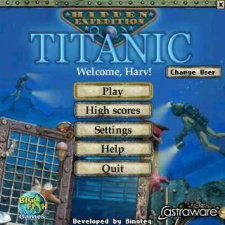
..since I did a game review. Quite a while. Before joining TreoCentral.com, I wrote a couple hundred PalmOS-centric reviews and articles for a now-defunct, nationally-distributed print magazine, whose focus was the hand-held market. Most of the time, my main review platform, the one on which I installed, tested, and evaluated tons of software for review, was the revolutionary Tapwave Zodiac II (which I still think was the most advanced and innovative non-phone PalmOS PDA ever made.
While I still have and occasionally use my Zod, for which Tapwave loaded me up with every accessory they made for it (and they were really nice folks with which to do business, and I miss them all).. earlier this year, I even sourced on eBay, bought, and transplanted a new, beefier battery into it, and it still works perfectly.
Even though it's long-gone from retail store shelves, all you have to do is check open and closed auctions on eBay or sites like Tapland.com to know that there are still legions of devoted Zodiac fans who are buying, clinging to, and using theirs, despite Tapwave abruptly shutting its doors and orphaning the platform a couple years ago.
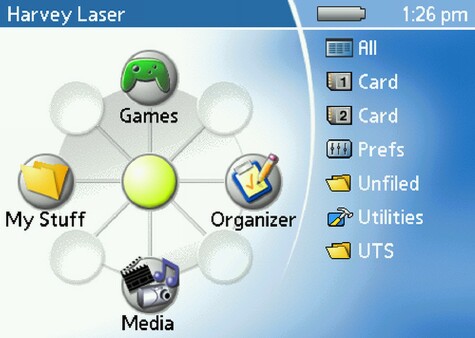
Although its guts was PalmOS Garnet V5, (with a radically different apps launcher interface), the physical layout of its controls and features: (analog joystick, "shoulder" trigger buttons, beautiful, rotatable, half-VGA screen, Stereo speakers, a "real" 3.5mm headphone jack, 128mb of Internal memory (unfortunately, not NVFS, so keeping a charge on its battery was critically important).. TWO SD slots, WiFi-capable and its use of sound and video co-processors to take the load of doing everything off its CPU, although it was an extremely powerful PalmOS PDA, its physical configuration and its guts made it perhaps the ultimate PalmOS gaming platform.
Not only could it run just about any PalmOS game that already existed, but many software developers coded new games targeted specifically to the Zodiac's radically cool capabilities and hardware. Tapwave filled my mailbox with SD cards full of insanely cool games, some of which I have to sheepishly admit, were so complicated, I could never totally figure out how to play them, while others were absolutely addictive and I obsessively played them daily.
Those of you who owned or still own a Zodiac should know exactly what I'm talking about. Like the Amiga computer, the Zodiac was probably ahead of its time, wasn't properly marketed (or even understood by those stores that carried it), and I can only imagine what it might have evolved into, had Tapwave survived.
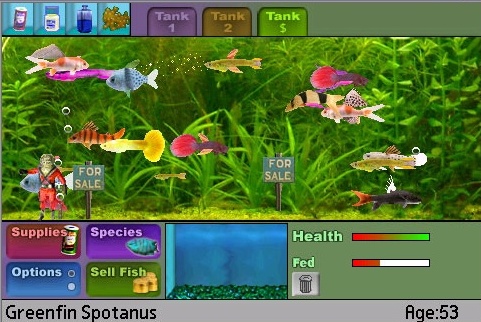
At any rate, my gaming proclivities tend more towards thinking / puzzle / logic games than action / shoot'em up / violent titles. When I play computer or hand-held games, I do it for relaxation, not stimulation. I'm no teenager. Because, in a way, it's vaguely reminiscent to the brand new game that's the subject of this review, when I first ran Titanic, it reminded me a bit of my Zodiac favorite: LDW Software's wonderful "Fish Tycoon." I can't even count how many hundreds of hours I played that game, and it's still available and should be Treo-compliant, although the Zodiac was the only platform on which I ever ran it.
What made FT so special was that, while it fell into the "virtual pet" category which was born long ago with the little Tamagotchi keychain game, it went far beyond that tiny toy in every imaginable way. FT was an aquarium simulation where you tossed in a few fish eggs, raised, cross-bred, and cared for dozens of species of tropical fish, which were rendered and were animated so realistically it was hard to believe they weren't real. Then, as they grew, you'd move them into a fish store scene and try to sell them at the right price in order to build up your bankroll, buy more advanced aquarium accessories, to buy more exotic fish eggs, and on and on. FT even multitasked, so you could run it in the background while you performed other handheld tasks, and put it into a suspended state that turned it into a stunning aquarium screen saver.
A new partnership delivers a beautiful new Treo-friendly game

So while Astraware's new title is not an aquarium simulator, in some ways, it reminds me of Fish Tycoon, although its game play is radically different. The similarities are mainly that this new game has some wonderfully realistic, animated fish, and similarly jaw-dropping graphics throughout.
Another is that the real joy of Titanic for me, personally, is that it's a simple, gentle, yet very beautiful game. This is not a shoot'em up. There are no monsters to fight, no violence, and you don't have to work yourself into a foaming frenzy to play and enjoy it.
Palm and all PDA gamers should be familiar with UK-based Astraware, developers of some of the best games around, like Astraware Sudoku, Zap! 2000/2016, PopCap Games' Bejeweled I and II, Zuma, and Insaniquarium, and Sandlot Games' Tradewinds, and Glyph.
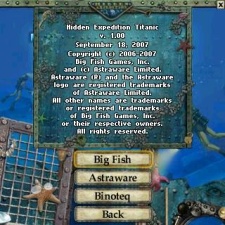
Astraware is a Microsoft Certified Gold Partner. Mobile gaming enthusiasts have downloaded more than 50 million (!!) copies of Astraware's products, and the company has customers in more than 100 countries. They're renowned not only for the quality of their games, but their excellent reputation for delivering a quality play experience at a reasonable price, and providing free trial versions of everything they make.
Just released in late September, 2007, Hidden Treasure: Titanic, is Astraware's first game done in partnership with Big Fish Games, a developer, publisher and distributor of casual, family-friendly computer (desktop or laptop).. games, who boasts one of the largest and highest-quality game catalogs on the Internet. With more than 1,000 titles to choose from, partnerships with more than 400 game developers, and "A New Game Every Day" for its customers, Big Fish is, perhaps, the world's leading casual game portal, distributing in excess of 750,000 games per day from their Web site.
Astraware's development team has done a brilliant job of re-creating this BFG title for the much smaller screen.
Multi-platform.
Hidden Expedition: Titanic (hereafter, just "Titanic"), is available for modern PalmOS, Windows Mobile, and Windows "smartphone" PDAs and phones, so it should be compatible with all current model Treos. I installed and tested it on my Sprint Treo 700p.
The ship, the legend..
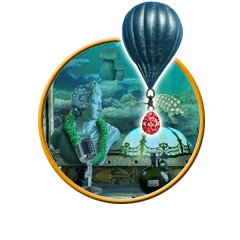
The stuff of legends, and tragic reality, the "unsinkable" RMS Titanic, which disastrously hit an iceberg, split in half, and sank on its maiden voyage, in April, 1912, was nicknamed "The ship of dreams." There've been literally dozens of feature films and documentaries about the sinking of the Titanic, the most famous of which in contemporary culture, is probably James Cameron's 1997 (has it really been ten years?) mega-hit, "Titanic", although many film critics opine that 1958's "A Night to Remember" was probably more factually accurate.
The trick to writing a game review is not to give too much away, so I'll try to hit what I think are the high points of Titanic, and, since it's available as a free trial, you can check it out yourself and if enticed by what you see, and want the full experience, buy it.
Card friendly..
Titanic downloads from Astraware in a .Zip file, inside of which, in the PalmOS version, is a single .prc (program) file, about six meg. Just install it in any of the usual ways onto your Treo's card. You CAN install it to Internal memory, but due to its size, card installation is probably wiser. Just make sure you have at least six meg of Internal memory available on your Treo, as when you launch Titanic from your card, because it copies itself into Internal RAM before it starts, and removes and cleans up after itself when you quit. Launching it takes about twenty seconds or so.

There's no separate manual supplied with the game. The first time you run it, you're presented with a sequence of screens of introductory text, which lead you into its main menu system.
You can play Titanic with your stylus, your finger, or entirely one-handed with a Treo's d-pad.
Assuming you've purchased it and have the registration code from Astraware, enter that, and then you're taken to a screen where you enter your name or nickname. Up to six different "slots" are provided, and since the game remembers the exact state it was in each time you quit it, up to six different people can play it (separately) on the same Treo or other handheld, and each player's position and score is remembered when the game is launched the next time.
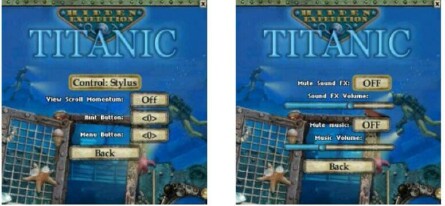
Titanic's main menu provides buttons with which you're a tap away from instructions, help, and hints, and a number of Preferences to control the background music, sound effects, and other parameters.
The Play's the Thing..
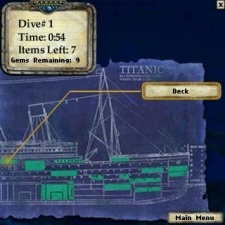
As the game begins, the Titanic has already met its watery doom and is resting down in Davey Jones' locker.
The mammoth ship still houses a wealth of common artifacts and priceless treasures. Your goal is to explore the wreckage of this once-majestic ship and collect antique artifacts for the Titanic Museum.
As you scroll around each beautifully-rendered room or area of the huge ship, you hunt for hidden objects within the wreckage during different diving missions, ultimately leading to the final prize: The Crown Jewels.
Although "shrunken down" to handheld size from computer size, Titanic features the same stunning graphics and atmosphere of the original, so you can appreciate that with all of these screens, graphics, animations, music, and sound effects, that's why the .prc file is the size it is.
Hey, no cheating!..
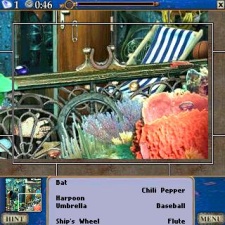
The game is about exploring the ship and finding objects. It's very much a "puzzle adventure" rather than an action game. There are 17 locations in the ship which you explore through 14 "dives." Each dive consists of 2 or 3 locations within the ship, plus each dive level is followed by a separate mini game. Some of the mini games require you to re-arrange photographs, some are additional searches. The final mini game is the one you must play to unlock the final
prize of the Crown Jewels.
Once you've completed a level and found all the objects in those 2 or 3 locations, congratulations, you're taken to the next level.
When looking at screens absolutely crammed with different objects and having to find and tap on certain ones from a list might seem easy in concept, but it's not. And you don't have all the time in the world to do it, either.
For instance, here's one area of one of the first locations, where I had to find a scrub brush..
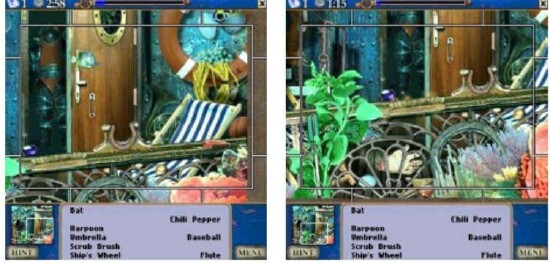
In each location, you're presented with a randomized list of objects you must locate in that scene, and tap on it. Do it correctly, and you'll see an animation as that object grows a balloon and it floats topside where your crew retrieves it. But there's another factor that comes into play here.
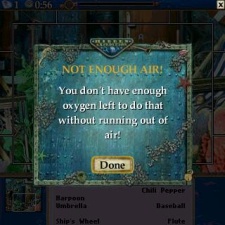
You're wearing an Oxygen tank, whose remaining air is shown on a bar at the top of the screen. As you explore each location looking for the required treasures, or just sit there doing nothing, you're using up Oxygen.. so you don't have the leisure of unlimited time to find each required object in each location's "shopping list" which is displayed at screen bottom.
The graphics are extremely dense and there are dozens of treasure objects in each location, so you might see that you need to find a compass, or a butterfly, or a flute amongst dozens of other things, be staring right at them, and not be able to pick them out.
To aid you, there's a "hint" button in the lower left of each scene.. tap that, and you're taken directly to one of your required treasures, where you can tap it, and it floats up, out of the scene and is removed from the list, but each time you use a hint, it uses extra Oxygen, so hinting your way through the scenes is done at a penalty of running out of air before you can finish that scene and move to the next one.
You can't progress to the next level of the game until you finish the level you're on. It's not as easy as it looks. Fail a level, and when you replay it, you're given an entirely different, randomized list of treasures and objects to find and remove. Everything on the list is in the scene, but it's not easy to find them in these jam-packed scenes, as you also have to keep an eye on your Oxygen level..
The game versus the movie what is reality?..
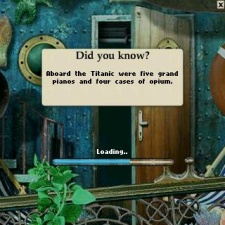
Astraware has taken some artistic liberty with reality here. The real Titanic hit sea bottom a couple of miles down. If you remember in Cameron's film, Brock Lovett (portrayed by Bill Paxton) and his crew had to explore the ship in special deep-sea diving rigs, and early in the film he makes a comment to the effect that the glass in the portholes of these rigs is nine inches thick.. he and his fellow explorers would be instantly squished at that insane depth should there be a hull breach or a window crack.
In the game, you're looking at everything from a first person point of view.. are you in one of those deep-sea rigs? Well, there's no control panel or fleet of little remote-controlled, camera-equipped robots to explore the ship and move objects for you. Obviously, you couldn't put on a diving suit and weights and walk around the Titanic at that depth.. you're just there, alone. There's no crew to help you. In that sense, it's kind of like wandering around alone in an old Infocom game, although the treasures you need to find to complete a level and move on are always displayed on screen. It's finding and tapping them before you run out of Oxygen that gives the game its playability and challenge.
What if a call comes in?..
Should you be interrupted by a phone call, the game will save
your progress and exit allowing you to take your call.
Titanic doesn't require a data connection. It's a game for solo play - ideal for a quick 5 minute level, or more extended play when you have time. As mentioned earlier, there are 6 different "User slots" though, so you can let other friends or family play the game on the same device, and have their own high scores.
Incidentally, High Scores, are an added feature that Astraware included in the handheld version. They aren't in Big Fish Games' original PC game.
Next Page: Conclusion >>